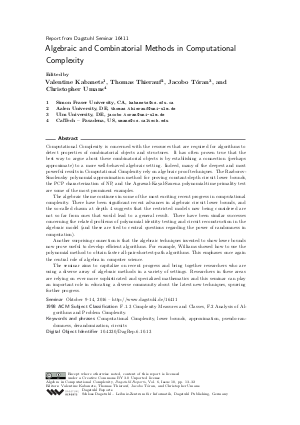Algebraic Methods in Computational Complexity (Dagstuhl Seminar 16411)
Authors Valentine Kabanets, Thomas Thierauf, Jacobo Tóran, Christopher Umans and all authors of the abstracts in this report
-
Part of:
Issue:
Dagstuhl Reports, Volume 6, Issue 10
Part of: Volume: Dagstuhl Reports, Volume 6
Part of: Journal: Dagstuhl Reports (DagRep) - License:
 Creative Commons Attribution 3.0 Unported license
Creative Commons Attribution 3.0 Unported license
- Publication Date: 2017-02-13
File

PDF
DagRep.6.10.13.pdf
- Filesize: 0.94 MB
- 20 pages
Document Identifiers
Subject Classification
Keywords
- Computational Complexity
- lower bounds
- approximation
- pseudo-randomness
- derandomization
- circuits
Metrics
- Access Statistics
-
Total Accesses (updated on a weekly basis)
0Document
0Metadata
Abstract
Computational Complexity is concerned with the resources that are required for algorithms to detect properties of combinatorial objects and structures. It has often proven true that the best way to argue about these combinatorial objects is by establishing a connection (perhaps approximate) to a more well-behaved algebraic setting. Indeed, many of the deepest and most powerful results in Computational Complexity rely on algebraic proof techniques. The Razborov-Smolensky polynomial-approximation method for proving constant-depth circuit lower bounds, the PCP characterization of NP, and the Agrawal-Kayal-Saxena polynomial-time primality test are some of the most prominent examples. The algebraic theme continues in some of the most exciting recent progress in computational complexity. There have been significant recent advances in algebraic circuit lower bounds, and the so-called chasm at depth 4 suggests that the restricted models now being considered are not so far from ones that would lead to a general result. There have been similar successes concerning the related problems of polynomial identity testing and circuit reconstruction in the algebraic model (and these are tied to central questions regarding the power of randomness in computation). Another surprising connection is that the algebraic techniques invented to show lower bounds now prove useful to develop efficient algorithms. For example, Williams showed how to use the polynomial method to obtain faster all-pair-shortest-path algorithms. This emphases once again the central role of algebra in computer science. The seminar aims to capitalize on recent progress and bring together researchers who are using a diverse array of algebraic methods in a variety of settings. Researchers in these areas are relying on ever more sophisticated and specialized mathematics and this seminar can play an important role in educating a diverse community about the latest new techniques, spurring further progress.
Cite As Get BibTex
Valentine Kabanets, Thomas Thierauf, Jacobo Tóran, and Christopher Umans. Algebraic Methods in Computational Complexity (Dagstuhl Seminar 16411). In Dagstuhl Reports, Volume 6, Issue 10, pp. 13-32, Schloss Dagstuhl – Leibniz-Zentrum für Informatik (2017)
https://doi.org/10.4230/DagRep.6.10.13
BibTex
@Article{kabanets_et_al:DagRep.6.10.13,
author = {Kabanets, Valentine and Thierauf, Thomas and T\'{o}ran, Jacobo and Umans, Christopher},
title = {{Algebraic Methods in Computational Complexity (Dagstuhl Seminar 16411)}},
pages = {13--32},
journal = {Dagstuhl Reports},
ISSN = {2192-5283},
year = {2017},
volume = {6},
number = {10},
editor = {Kabanets, Valentine and Thierauf, Thomas and T\'{o}ran, Jacobo and Umans, Christopher},
publisher = {Schloss Dagstuhl -- Leibniz-Zentrum f{\"u}r Informatik},
address = {Dagstuhl, Germany},
URL = {https://drops.dagstuhl.de/entities/document/10.4230/DagRep.6.10.13},
URN = {urn:nbn:de:0030-drops-69504},
doi = {10.4230/DagRep.6.10.13},
annote = {Keywords: Computational Complexity, lower bounds, approximation, pseudo-randomness, derandomization, circuits}
}
